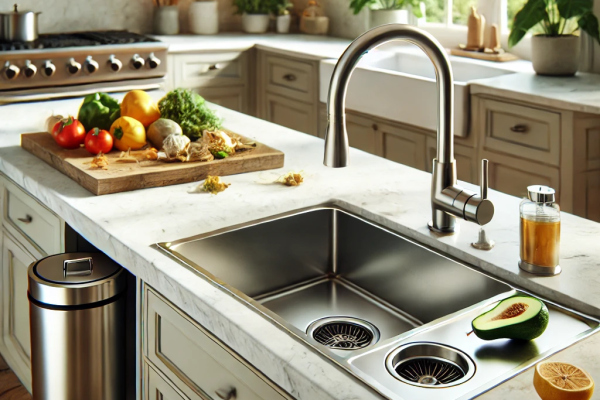
Choosing the Right Garbage Disposal: A Buyer’s Essential Guide
Introduction: Why the Right Garbage Disposal Matters
Imagine this: you're cleaning up after a big family dinner. Dishes are stacked high, and you're ready to send those food scraps straight down the sink. But your garbage disposal whines, sputters, and finally... dies. You’re left with a messy sink and a sinking feeling.
Buying a new garbage disposal might not be glamorous, but it’s one of those decisions that can make or break your kitchen’s functionality. Whether you’re upgrading an old unit or purchasing one for the first time, getting the right disposal can save you time, stress, and even money. This guide will break down everything you need to know—from power ratings to installation tips—so you can make an informed decision and avoid common pitfalls.
In Texas, where warm weather often means more cooking and entertaining, having a reliable garbage disposal can make a big difference in how smoothly your kitchen runs. From backyard barbecues in Austin to family meals in San Antonio, a good disposal will help keep your kitchen cleanup quick and easy.
Do You Really Need a New Garbage Disposal?
Before rushing to the hardware store or clicking “Buy Now” online, take a moment to assess whether you actually need a new garbage disposal. Here are some signs your disposal is on its last legs:
Signs You Need a Replacement
- Unusual Noises: Grinding, rattling, or screeching could mean worn-out parts.
- Frequent Clogs: If it clogs even with soft scraps, the blades may be dull.
- Persistent Odors: Bad smells that won’t go away might indicate residue buildup.
- Leaks or Rust: If water leaks under your sink or the unit shows rust, it’s time for a replacement.
Sometimes, however, a simple repair will do the trick. If you’re unsure, consult a plumber—it might save you a few hundred dollars.
Types of Garbage Disposals: Which One Is Right for You?
There are two main types of garbage disposals: continuous feed and batch feed. Here’s what you need to know about each:
Continuous Feed Disposals
- How It Works: This type runs as long as the switch is on, letting you scrape food into the unit continuously.
- Best For: Busy households and frequent use.
- Pros: Convenient, fast, and widely available.
- Cons: Requires a power switch and can be dangerous if misused (e.g., dropping utensils).
Batch Feed Disposals
- How It Works: Operates only when you place a stopper over the opening and turn it on.
- Best For: Families with safety concerns or small kitchens.
- Pros: Safer for kids, quieter, and uses less power.
- Cons: Slower to process large amounts of food.
Key Factors to Consider Before Buying
When shopping for a garbage disposal, keep these factors in mind:
Motor Power (HP)
Garbage disposals come in different horsepower (HP) ratings:
- 1/3 HP: Entry-level, suitable for very light use (e.g., apartments).
- 1/2 HP: A solid choice for small households.
- 3/4 HP: Best for average families. Handles tougher scraps like small bones.
- 1 HP and Above: Ideal for large families or those who cook often.
Pro Tip: Go for at least 3/4 HP if you want durability and fewer clogs.
Noise Levels
No one likes the sound of a jet engine in their kitchen. Modern disposals come with noise insulation features—look for terms like "SoundSeal” or “Quiet Series.” Batch feed models tend to be quieter by design.
Material and Build Quality
- Stainless Steel Blades: More durable and rust-resistant.
- Corrosion Protection: Look for units with anti-corrosion coatings, especially if you use hard water.
Ease of Installation
Most disposals can be DIY-installed, but some units come with extra features like a power cord or EZ-mount systems for quicker setup. If you’re not confident with plumbing, hiring a professional is worth the cost.
Price and Warranty
- Basic models start around $70-100, while high-end units can cost $300+.
- Warranties range from 1 year to 10+ years. A longer warranty often indicates better build quality.
How to Extend the Life of Your Garbage Disposal
A well-maintained garbage disposal can last over a decade. Follow these simple tips to keep yours running smoothly:
- Run Cold Water: Always use cold water when operating the disposal. It helps solidify grease and oils, preventing clogs.
- Clean Regularly: Freshen your disposal by grinding ice cubes and citrus peels. The ice sharpens blades, while the citrus eliminates odors.
- Avoid Hard Items: Never grind bones, shells, or glass—they can damage the blades.
- Don’t Overload It: Feed scraps gradually instead of dumping everything at once.
- Use Baking Soda and Vinegar: Once a month, pour baking soda followed by vinegar down the disposal to break down buildup.
Troubleshooting Common Garbage Disposal Problems
Before you call a plumber, try these quick fixes for common disposal issues:
The Disposal Won’t Turn On
- Check if it’s plugged in and the circuit breaker hasn’t tripped.
- Press the reset button located on the bottom of the unit.
It’s Jammed
- Turn off the power.
- Use a hex wrench to manually turn the blades from the bottom.
Strange Noises
- Turn off the unit and check for foreign objects like utensils.
Slow Draining
- Clear the pipes with a mixture of baking soda and vinegar.
Popular Brands and Models to Consider
Here are some trusted garbage disposal brands:
- InSinkErator: Known for reliability and quiet operation.
- Waste King: Affordable, powerful units with long warranties.
- Moen: Sleek designs with easy installation.
Top Pick: The InSinkErator Evolution Excel—quiet, powerful, and durable for busy kitchens.
Environmental Impact of Garbage Disposals
Garbage disposals help reduce food waste in landfills, but they also impact water usage and sewage systems. Here’s how to minimize your environmental footprint:
- Compost When Possible: Use disposals only for scraps you can’t compost.
- Run Efficiently: Avoid leaving the water running unnecessarily.
- Choose Energy-Efficient Models: Look for disposals with energy-saving features.
Installation Tips: DIY or Professional Help?
If you’re handy, installing a new garbage disposal can be a weekend project. Here’s a basic overview:
- Turn Off Power: Safety first—shut off the power to your sink area.
- Remove the Old Unit: Disconnect the plumbing and mounting ring.
- Install the New Mount: Follow the manufacturer’s instructions.
- Connect the Disposal: Attach it to the sink and plumbing.
- Test for Leaks: Run water and check all connections.
When to Call a Pro: If you’re not comfortable with plumbing or electrical work, hiring a professional ensures the job is done right.
Final Thoughts: Making the Right Choice
A garbage disposal may not be the star of your kitchen, but it plays a vital role in keeping things clean and convenient. By understanding your needs, budget, and the features that matter most, you can choose a unit that will serve you well for years to come.
So, whether you’re a seasoned chef in Dallas, a busy parent in Houston, or just someone who wants an easier cleanup in a small Texas town, investing in the right garbage disposal will make kitchen life smoother and stress-free.
Happy Shopping, and may your sink stay clog-free!






